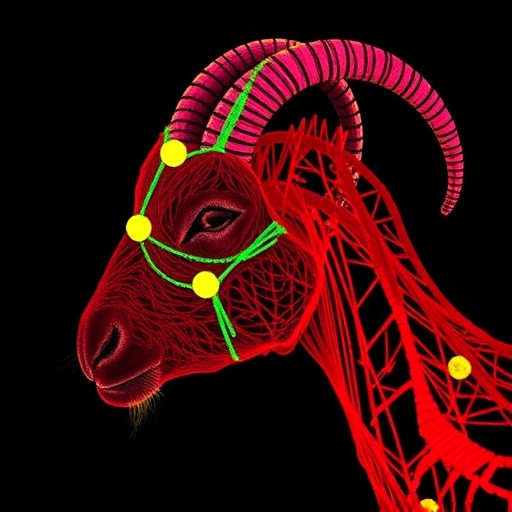In recent advancements in reproductive biology, the role of Neuromedin B (NMB) in ovarian physiology has gained significant attention. A groundbreaking study conducted by Xia, R., Zhang, Q., and Shao, J. and published in the Journal of Ovarian Research has shed light on this intriguing peptide’s influence on goat granulosa cells. This investigation highlights how NMB drives the proliferation of these cells through mechanisms mediated by its receptor, Neuromedin B receptor (NMBR), and its impact on cellular calcium homeostasis.
Granulosa cells, found in the follicles of ovaries, play a critical role in the development and maturation of oocytes. These cells not only support oocyte growth but also produce hormones that influence reproductive cycles. The proliferation of granulosa cells is a vital process in ensuring fertility and successful reproduction in livestock, and understanding the biochemical pathways involved is essential for enhancing reproductive efficiency. NMB emerges as a significant player in this context, linking neuropeptide signaling to granulosa cell behavior.
The study posits that NMB functions through its receptor, NMBR, a G-protein coupled receptor expressed on granulosa cells. Upon binding with NMB, NMBR activates intracellular signaling pathways that lead to an increase in intracellular calcium levels. Calcium ions serve as pivotal secondary messengers in various cellular processes, including proliferation. The surge in calcium levels following NMB stimulation prompts granulosa cells to enter the cell cycle, leading to proliferation. This profound connection between neuropeptide signaling and reproductive health offers exciting possibilities for enhancing fertility in goats.
Calcium homeostasis is fundamental for maintaining cellular function and viability. The study reveals that NMB’s action on granulosa cells not only elevates intracellular calcium concentrations but also modulates the expression of calcium transport proteins. Such proteins are critical for sustaining calcium balance within the cell, ensuring that the positive influence of NMB on granulosa cell proliferation is maintained. This study’s findings suggest that manipulating calcium dynamics could be a strategic approach to enhance ovary function in goat farming.
The implications of these findings extend beyond basic science. In agricultural settings, particularly in goat husbandry, understanding the molecular mechanisms governing ovary biology can lead to innovative breeding strategies. By harnessing NMB’s potential to stimulate granulosa cell proliferation, farmers may improve ovulation rates and overall reproductive performance in their herds. Moreover, this research provides a paradigm for exploring similar pathways in other livestock species, offering a broader impact on food production and sustainability.
In livestock management, reproductive efficiency is critical for economic viability. Understanding factors that enhance or inhibit granulosa cell function could lead to breakthroughs in animal husbandry. The use of NMB as a potential reproductive aid could provide farmers with new tools to manage fertility challenges more effectively, thus improving productivity and profitability. The study encourages further exploration of neuropeptide signaling in reproductive biology as a promising avenue for agricultural biotechnology.
Current trends in livestock reproduction emphasize the need for sustainable practices that ensure animal welfare while maximizing output. With growing concerns regarding animal health, the application of neuropeptides like NMB offers a more humane, biological approach compared to traditional chemical or hormonal treatments. This shift towards natural solutions resonates with consumers’ increasing demand for ethically produced animal products. The findings from Xia et al. could catalyze innovations that align agricultural practices with animal welfare principles.
Additionally, the broader impacts of this research could inform biomedical applications. Understanding calcium signaling pathways is essential not only in livestock but also in human health. Many reproductive issues, particularly those related to infertility, share common mechanisms with those observed in animal models. Insights into NMB’s role in granulosa cell proliferation may inspire new therapeutic strategies for managing human reproductive disorders, fostering a cross-disciplinary dialogue between veterinary and human medicine.
The study also opens avenues for investigating the possible interactions between NMB and other growth factors or hormones involved in ovarian function. The intricate web of signaling pathways in granulosa cells presents an exciting challenge for researchers aiming to dissect the molecular underpinnings of reproductive physiology. By understanding these interactions better, scientists can potentially uncover novel regulatory mechanisms that could be targeted for intervention, whether in agricultural or clinical settings.
As research continues unraveling the complexities of ovarian biology, the work of Xia and colleagues underscores the importance of multidisciplinary approaches. The fusion of molecular biology, endocrinology, and reproductive science is essential to advance our understanding. Future studies might delve deeper into the signaling cascades initiated by NMB and explore how environmental factors, such as stress or nutrition, could modulate these pathways.
The current research environment fosters collaboration, integrating knowledge from different scientific domains to tackle pressing issues in both reproductive health and agricultural productivity. By sharing findings and insights, researchers can accelerate the pace of discovery and innovation. The implications of NMB in enhancing goat fertility is just a glimpse of how integrative science can address complex biological questions, yielding benefits for animals and humans alike.
In conclusion, the discovery of Neuromedin B’s role in driving goat granulosa cell proliferation opens new frontiers in reproductive biology and animal husbandry. As research unfolds, it holds promise not only for improving livestock productivity but also for enhancing our understanding of reproductive mechanisms across species. The interplay between neuropeptides and calcium signaling will likely remain a focal area of research, illuminating pathways that can yield transformative impacts in various applications.
By harnessing the power of NMB and unraveling its signaling pathways, scientists and farmers alike stand poised to elevate reproductive health in livestock, ensuring food security and sustainability in an ever-evolving world.
Subject of Research: The role of Neuromedin B in goat granulosa cell proliferation and calcium homeostasis.
Article Title: Neuromedin B drives goat granulosa cell proliferation via NMBR-mediated calcium homeostasis.
Article References:
Xia, R., Zhang, Q., Shao, J. et al. Neuromedin B drives goat granulosa cell proliferation via NMBR-mediated calcium homeostasis.
J Ovarian Res 18, 276 (2025). https://doi.org/10.1186/s13048-025-01844-7
Image Credits: AI Generated
DOI: https://doi.org/10.1186/s13048-025-01844-7
Keywords: Neuromedin B, goat granulosa cells, calcium homeostasis, reproductive biology, livestock productivity, fertility, neuropeptide signaling.




